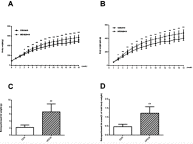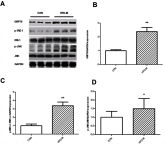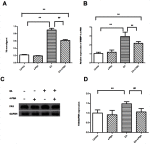Endoplasmic reticulum stress may be involved in insulin resistance and lipid metabolism disorders of the white adipose tissues induced by high-fat diet containing industrial trans-fatty acids
- PMID: 31507325
- PMCID: PMC6718956
- DOI: 10.2147/DMSO.S218336
Endoplasmic reticulum stress may be involved in insulin resistance and lipid metabolism disorders of the white adipose tissues induced by high-fat diet containing industrial trans-fatty acids
Abstract
Background: Consumption of industrially produced trans-fatty acids (iTFAs) can result in alteration to lipid profile and glucose metabolism. Moreover, a diet high in iTFAs could increase the risk of obesity, cardiovascular diseases (CVDs) and type 2 diabetes mellitus. Glucose and lipid metabolism are closely linked in white adipose tissue (WAT), yet the underlying mechanisms of the effect of iTFAs in WAT are poorly understood.
Materials and methods: Parameters of glucose homeostasis, lipid profiles and markers of endoplasmic reticulum (ER) stress of WAT were measured in rats maintained on a high-fat diet containing margarine (HFD-M) (n=10) compared to controls maintained on standard chow (n=10) over 16 weeks.
Results: Fat mass and body weight was significantly increased in rats maintained on the HFD-M compared to controls (P<0.01). HFD-M rats had increased levels of insulin (INS), homeostasis model assessment of insulin resistance and serum lipid profile was significantly altered. The expression of glucose-regulated protein 78 (GRP78) and the phosphorylation of inositol-requiring enzyme 1-alpha and c-Jun N-terminal kinase (JNK) were significantly increased in subcutaneous and retroperitoneal adipose depots of HFD-M-fed rats. In vitro, wider ER lumens were observed in 100μmol/L elaidic acid (EA)-treated human mature adipocytes. We observed activation of ER stress markers, impaired INS receptor signaling and increased lipogenesis in adipocytes after EA exposure. These effects could be alleviated by inhibiting ER stress in adipocytes in vitro.
Conclusion: Collectively these data suggest that ER stress may be involved in INS resistance and lipid metabolism disorders induced by high-fat diet containing iTFAs. These findings suggest that WAT could be regarded as a key target organ for inhibiting ER stress to reverse the impaired INS receptor signaling, alleviate lipid metabolism disorders, and provide a novel approach to prevent and treat INS resistance and dyslipidemia-related chronic diseases such as T2MD and CVDs.
Keywords: ER stress; adipocytes; dyslipidemia; elaidic acid; insulin resistance; obesity.
Conflict of interest statement
The authors declare no conflicts of interest in this work.
Figures







References
LinkOut - more resources
Full Text Sources
Research Materials
Miscellaneous

